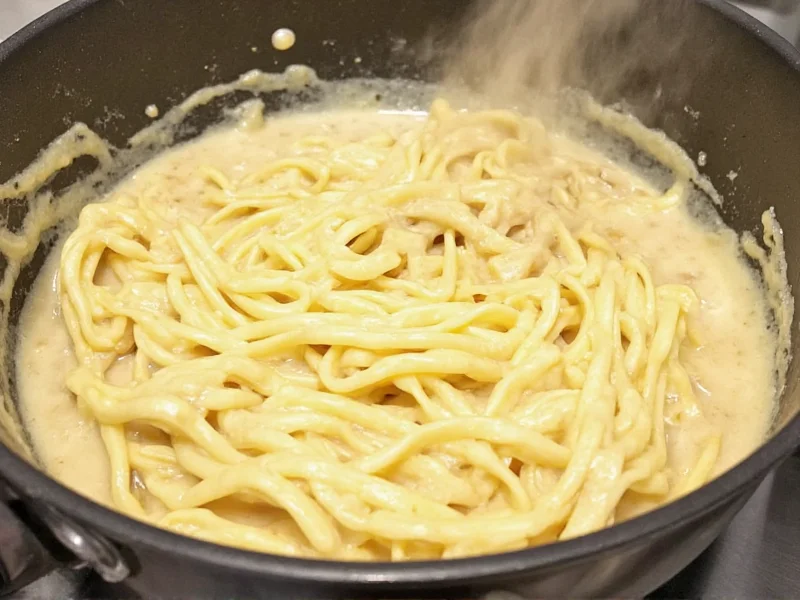Nothing ruins a comforting plate of fettuccine Alfredo faster than sauce that won't cling to your pasta. When your homemade Alfredo sauce turns out thinner than expected, it's usually due to preventable technique errors rather than flawed recipes. Understanding the science behind this classic emulsion helps both fix immediate problems and prevent future failures.
Why Your Alfredo Sauce Becomes Runny: 5 Common Culprits
Alfredo sauce relies on a delicate balance between dairy and cheese to create its signature velvety texture. When this equilibrium fails, you're left with a pool of liquid instead of a luxurious coating for your pasta.
1. Liquid-to-Cheese Ratio Imbalance
The most frequent cause of runny Alfredo is using too much cream or milk relative to the amount of cheese. Authentic Alfredo traditionally contains no cream—just butter, Parmesan, and pasta water. Many modern recipes incorporate cream for richness, but exceeding the recommended proportions prevents proper emulsification. For every cup of liquid, you typically need 1 to 1.5 cups of freshly grated Parmesan to achieve ideal thickness.
2. Temperature Mishaps During Cheese Incorporation
Adding cheese to boiling liquid causes the proteins to seize and separate rather than melt smoothly. The optimal temperature for incorporating Parmesan is between 160-180°F (71-82°C)—hot enough to melt the cheese but not so hot that it breaks the emulsion. Always remove your dairy base from heat before gradually whisking in cheese.
3. Using Pre-Grated Cheese Products
Store-bought shredded Parmesan contains anti-caking agents like cellulose that prevent proper melting. These additives interfere with the sauce's ability to thicken and create a smooth texture. For best results, use freshly grated Parmigiano-Reggiano with a microplane grater—its higher moisture content and absence of stabilizers create superior emulsification.
4. Improper Pasta Water Integration
While pasta water helps bind sauce to noodles, adding too much—or water that's excessively starchy—thins your Alfredo. Reserve no more than ¼ cup of pasta water, and add it gradually while stirring. The starch should enhance texture, not dilute your sauce.
5. Low-Fat Dairy Substitutions
Using skim milk or low-fat cream prevents proper emulsification since fat carries flavor and creates thickness. Full-fat dairy products contain the necessary fat content to bind with cheese proteins. When fat content drops below 30%, sauces struggle to maintain cohesion.
| Problem | Immediate Fix | Prevention Strategy |
|---|---|---|
| Excess liquid | Simmer uncovered 3-5 minutes | Measure liquids precisely; start with less |
| Cheese separation | Remove from heat; add 1 tbsp cold butter | Add cheese off-heat; maintain 160-180°F |
| Insufficient thickening | Add 2-3 tbsp grated Parmesan gradually | Use 1.5 cups cheese per cup liquid |
| Over-thinned by pasta water | Mix 1 tsp cornstarch with 1 tbsp cold water | Add pasta water sparingly (max ¼ cup) |
How to Fix Runny Alfredo Sauce: 4 Effective Methods
Simmering Reduction Technique
Gently simmer your sauce uncovered for 3-5 minutes, stirring constantly. As water evaporates, the remaining components concentrate, naturally thickening the sauce. Never boil vigorously—this causes separation. This method preserves original flavor while improving texture, making it ideal for sauces only slightly too thin.
Cheese Reinforcement Method
Gradually whisk in additional freshly grated Parmesan (¼ cup at a time) off direct heat. The new cheese incorporates smoothly without breaking, adding both thickness and authentic flavor. Avoid adding cheese directly to boiling liquid, which causes clumping. This approach maintains the sauce's traditional ingredient profile while correcting consistency.
Cold Butter Rescue
When sauce separates due to overheating, remove from heat and whisk in 1-2 tablespoons of cold, cubed butter. The fat re-emulsifies the mixture while the cold temperature helps proteins relax. This professional chef technique works particularly well for sauces that have visibly split.
Slurry Solution (Last Resort)
For severely runny sauces, create a slurry by mixing 1 teaspoon cornstarch with 1 tablespoon cold water. Whisk into simmering sauce and cook for 1 minute until thickened. While not traditional, this method provides reliable results when other approaches fail. Avoid flour-based thickeners, which create a pasty texture incompatible with delicate Alfredo.
Proven Strategies for Perfect Alfredo Sauce Every Time
Achieving restaurant-quality Alfredo requires attention to detail throughout the cooking process. These evidence-based techniques prevent common pitfalls that lead to runny results.
Master the Temperature Balance
Maintain your dairy base between 160-180°F when adding cheese. Use an instant-read thermometer for precision—this narrow range allows cheese to melt smoothly without protein denaturation that causes separation. Remove from heat completely before incorporating cheese, using residual heat to melt it gradually.
Optimize Ingredient Ratios
Follow this professional ratio for foolproof results: ½ cup (1 stick) unsalted butter, 1 cup heavy cream (or whole milk for lighter version), and 1½ cups freshly grated Parmigiano-Reggiano per pound of pasta. The higher cheese proportion creates a naturally thick emulsion that clings perfectly to noodles without additional thickeners.
Embrace the Power of Pasta Water
Reserve starchy pasta water before draining—this liquid gold contains amylopectin that helps sauce adhere to noodles. Add only 2-4 tablespoons to your finished sauce while tossing with pasta. The starch enhances texture without diluting flavor, creating that coveted "sauce hugs the pasta" effect.
Choose Quality Ingredients Strategically
Invest in authentic Parmigiano-Reggiano (minimum 12-month aged) for superior melting properties. Its crystalline structure dissolves smoothly into sauces, unlike pre-grated alternatives. For dairy, use pasteurized (not ultra-pasteurized) cream, which contains active enzymes that support emulsification. These premium ingredients cost slightly more but prevent costly do-overs.











 浙公网安备
33010002000092号
浙公网安备
33010002000092号 浙B2-20120091-4
浙B2-20120091-4